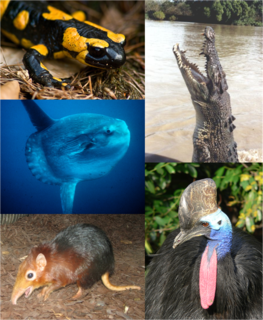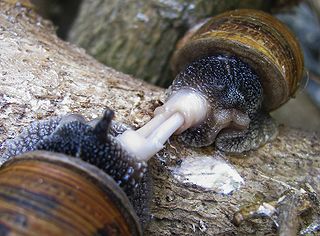
Seafood is any form of sea life regarded as food by humans. Seafood prominently includes fish and shellfish. Shellfish include various species of molluscs, crustaceans, and echinoderms. Historically, sea mammals such as whales and dolphins have been consumed as food, though that happens to a lesser extent in modern times. Edible sea plants, such as some seaweeds and microalgae, are widely eaten as seafood around the world, especially in Asia. In North America, although not generally in the United Kingdom, the term "seafood" is extended to fresh water organisms eaten by humans, so all edible aquatic life may be referred to as seafood. For the sake of completeness, this article includes all edible aquatic life.

Vertebrates comprise all species of animals within the subphylum Vertebrata. Vertebrates represent the overwhelming majority of the phylum Chordata, with currently about 69,276 species described. Vertebrates include the jawless fishes and jawed vertebrates, which include the cartilaginous fishes and the bony fishes.

A tuna is a saltwater fish that belongs to the tribe Thunnini, a subgrouping of the Scombridae (mackerel) family. The Thunnini comprise 15 species across five genera, the sizes of which vary greatly, ranging from the bullet tuna up to the Atlantic bluefin tuna. The bluefin averages 2 m (6.6 ft), and is believed to live up to 50 years.

Mackerel is a common name applied to a number of different species of pelagic fish, mostly from the family Scombridae. They are found in both temperate and tropical seas, mostly living along the coast or offshore in the oceanic environment.

Herring are forage fish, mostly belonging to the family Clupeidae.

Reel Big Fish is an American ska punk band from Orange County, California, best known for the 1997 hit "Sell Out". The band gained mainstream recognition in the mid-to-late 1990s, during the third wave of ska with the release of the gold certified album Turn the Radio Off. Soon after, the band lost mainstream recognition but gained an underground cult following. As of 2006, the band is no longer signed to a major record label, and has since been independent. After many line-up changes throughout the years, front man Aaron Barrett is the only remaining founding member in the band.

Sturgeon is the common name for the 27 species of fish belonging to the family Acipenseridae. Their evolution dates back to the Triassic some 245 to 208 million years ago. The family is grouped into four genera: Acipenser, Huso, Scaphirhynchus and Pseudoscaphirhynchus. Four species may now be extinct. Two closely related species, Polyodon spathula and Psephurus gladius are of the same order, Acipenseriformes, but are in the family Polyodontidae and are not considered to be "true" sturgeons. Both sturgeons and paddlefish have been referred to as "primitive fishes" because their morphological characteristics have remained relatively unchanged since the earliest fossil record. Sturgeons are native to subtropical, temperate and sub-Arctic rivers, lakes and coastlines of Eurasia and North America.

Swordfish, also known as broadbills in some countries, are large, highly migratory, predatory fish characterized by a long, flat bill. They are a popular sport fish of the billfish category, though elusive. Swordfish are elongated, round-bodied, and lose all teeth and scales by adulthood. These fish are found widely in tropical and temperate parts of the Atlantic, Pacific, and Indian Oceans, and can typically be found from near the surface to a depth of 550 m (1,800 ft). They commonly reach 3 m (9.8 ft) in length, and the maximum reported is 4.55 m (14.9 ft) in length and 650 kg (1,430 lb) in weight.

Groupers are fish of any of a number of genera in the subfamily Epinephelinae of the family Serranidae, in the order Perciformes.

The term fish kill, known also as fish die-off, refers to a localized die-off of fish populations which may also be associated with more generalized mortality of aquatic life. The most common cause is reduced oxygen in the water, which in turn may be due to factors such as drought, algae bloom, overpopulation, or a sustained increase in water temperature. Infectious diseases and parasites can also lead to fish kill. Toxicity is a real but far less common cause of fish kill.
Ernstichthys is a genus of banjo catfishes that occurs in the Amazon and Orinoco basins.
Micromyzon akamai is a species of catfish in the family Aspredinidae.

The green chromide is a species of cichlid fish from freshwater and brackish water in southern India and Sri Lanka. Other common names include pearlspot cichlid, banded pearlspot, and striped chromide. In Kerala in India it is known locally as the karimeen. In Goa the fish is known as Kalundar In Sri Lanka this fish is known as Koraliya

In biology, a hermaphrodite is an organism that has complete or partial reproductive organs and produces gametes normally associated with both male and female sexes. Many taxonomic groups of animals do not have separate sexes. In these groups, hermaphroditism is a normal condition, enabling a form of sexual reproduction in which either partner can act as the "female" or "male." For example, the great majority of tunicates, pulmonate snails, opisthobranch snails, earthworms and slugs are hermaphrodites. Hermaphroditism is also found in some fish species and to a lesser degree in other vertebrates. Most plants are also hermaphrodites.
Ernstichthys megistus is a species of banjo catfish found in Ecuador and Peru where it occurs in the Bobonaza and Marañon River basins. It grows to a length of 6.7 cm (2.6 in).

Pescetarianism is the practice of following a diet that includes fish and other seafood, but not the flesh of other animals. Those on pescetarian or pollotarian diets may define "meat" only as mammalian flesh and may identify as vegetarians. Most pescetarians are lacto-ovo vegetarians with the addition of fish and shellfish, described as "fish but no other meat". The common use association between such diets and vegetarianism has led groups such as the Vegetarian Society to state that diets containing these foods are not vegetarian.
Juxtaxanthias is a genus of crabs in the family Xanthidae, containing the following species:

Fins are usually the most distinctive anatomical features of a fish. They are composed of bony spines or rays protruding from the body with skin covering them and joining them together, either in a webbed fashion, as seen in most bony fish, or similar to a flipper, as seen in sharks. Apart from the tail or caudal fin, fish fins have no direct connection with the spine and are supported only by muscles. Their principal function is to help the fish swim. Fins located in different places on the fish serve different purposes such as moving forward, turning, keeping an upright position or stopping. Most fish use fins when swimming, flying fish use pectoral fins for gliding, and frogfish use them for crawling. Fins can also be used for other purposes; male sharks and mosquitofish use a modified fin to deliver sperm, thresher sharks use their caudal fin to stun prey, reef stonefish have spines in their dorsal fins that inject venom, anglerfish use the first spine of their dorsal fin like a fishing rod to lure prey, and triggerfish avoid predators by squeezing into coral crevices and using spines in their fins to lock themselves in place.
















